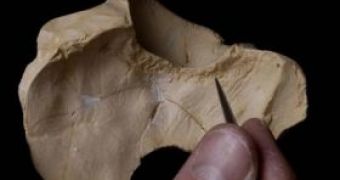Annually, HIV and pneumonia kill about 2 million people. Tuberculosis is caused by the Koch bacterium and the oldest TBC was found in mummies coming from ancient Egypt and Peru, being thousands of years old. About 150 million people have died of TBC, since 1914.
One third of the people carry the Koch bacterium, which spreads through the air and affects all the body, especially the lungs. It induces prolonged coughing, fever, shivering, bloody expectoration, weight loss, sweating, tiresomeness, and glossy eyes. 8 million new cases appear each year.
It is worldwide spread, but its advance is rampant in Bangladesh, China, Indonesia, Philippines, India and Pakistan, with over 50 % of new cases.
Now, a research, made at the University of Texas at Austin and published in the "American Journal of Physical Anthropology", shows that TBC has an age that is much older than those mummies: at least 500,000-year-old, as revealed by a fossil of Homo erectus (a direct ancestor of Homo sapiens) from Turkey. The research fits the theory that dark-skinned people migrating northward from tropics produced less vitamin D, which plummeted their immune system, not only the amount of calcium that entered the skeleton.
Homo erectus is the first human species that went out of Africa, up to China, Indonesia and Europe.
The new Homo erectus fossil belonged to a young male. Small lesions encountered into the skull were similar to Leptomeningitis tuberculosa, typical to Kock bacterium attacking the meninges of the brain.
Medical literature signals that some groups of people are more vulnerable to TBC, like Gujarati Indians living in London, and Senegalese conscripts from the French army during World War I. Both populations have migrated from tropics to northern temperate areas and are dark skinned. Dark skin means less UV light penetrates the skin for the synthesis of vitamin D, because of the black pigment called melanin. That's why in northern areas with lower UV radiation, like Europe, these people can experience impaired immune systems.
"It is likely that Homo erectus had dark skin because it evolved in the tropics. After the species moved north, it had to adapt to more seasonal climates. " said co-author John Kappelman, professor of anthropology at The University of Texas at Austin. The young male's body could have synthesized less vitamin D, plummeting his immune system, and turning it vulnerable to tuberculosis.
"Skin color represents one of biology's most elegant adaptations. The production of vitamin D in the skin serves as one of the body's first lines of defenses against a whole host of infections and diseases. Vitamin D deficiencies are implicated in hypertension, multiple sclerosis, cardiovascular disease and cancer." said Kappelman.
Before antibiotics treatments, TBC patients were sent to sanatoria with plenty of sunshine and fresh air.
"No one knew why sunshine was integral to the treatment, but it worked. Recent research suggests the flush of ultraviolet radiation jump-started the patients' immune systems by increasing the production of vitamin D, which helped to cure the disease." said Kappelman.

 14 DAY TRIAL //
14 DAY TRIAL //